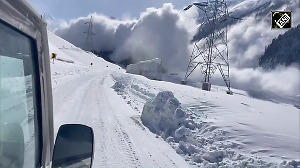Air travellers have come to recognise as routine the gut-wrenching sensation they experience as their flight jostles after hitting an 'air-pocket' -- scientifically known as turbulence.
Indian researcher Manikandan Mathur is part of a group of Massachusetts Institute of Technology that claims to have found out the mystery behind a phenomenon that often causes among other things unexpected jolts in flights making aircraft to bounce and dip in mid-air.
This they say could ultimately help engineers design better planes, cars, submarines and engines and also reduce oceanic pollution.
The results of the research will be published in an upcoming issue of the Physical Review Letters, according to news from MIT.
What exactly is turbulence? Delhi-based Professor of Physics Dwarkanath Mulherkar explains: "It is anything
"You could say it is like when a stream of water flows over shoals of rocks or practically any phenomena involving fluid flow such as air and gas mixing in an engine or air whipping across a vehicle's surface," he says.
In daily life, the swirls of smoke puffed out from a cigarette, or the swathes of cream poured into coffee or ocean waves breaking on a cliff all count as turbulence.
Auto design guru Dilip Chabbaria says the research may lead to cars being designed faster, cleaner and more efficient. "Turbulence basically means drag. Though this breakthrough if we can get around that then it definitely pushes designing (automobiles) up two or three stages higher. Definitely we can see faster cars on the roads."






 © 2025
© 2025